The Truth About Casino Security Animals: Debunking a Persistent Myth
Origins of the Casino Animal Security Myth
The widespread belief that casinos use trained animals for security purposes stems from a sensationalized 1973 tabloid story. This urban legend has evolved over decades, spawning increasingly elaborate tales about exotic animals detecting nervous gamblers and potential cheaters.
Modern Casino Security Methods
Rather than relying on animals, today's casinos employ sophisticated technological surveillance systems. These include:
- AI-powered monitoring systems
- Advanced facial recognition software
- Statistical analysis programs
- High-definition security cameras
- RFID chip tracking
Social Media's Role in Myth Propagation
The rise of social media has significantly amplified this false narrative through:
- Coordinated misinformation campaigns
- Manipulated security footage
- Doctored photographs
- Viral storytelling
Actual Casino Security Measures
Technology-Based Solutions
Modern casinos utilize state-of-the-art surveillance technology integrated with:
- Machine learning algorithms
- Behavioral analysis software
- Digital tracking systems
Human Elements
Professional security teams employ:
- Trained surveillance specialists
- Floor supervisors
- Gaming experts
- Risk management professionals
The reality of casino security relies on human expertise combined with cutting-edge technology, not trained animals. Understanding these facts helps dispel persistent myths while highlighting the sophisticated nature of actual casino security operations.
Origins of the Animal Security Myth
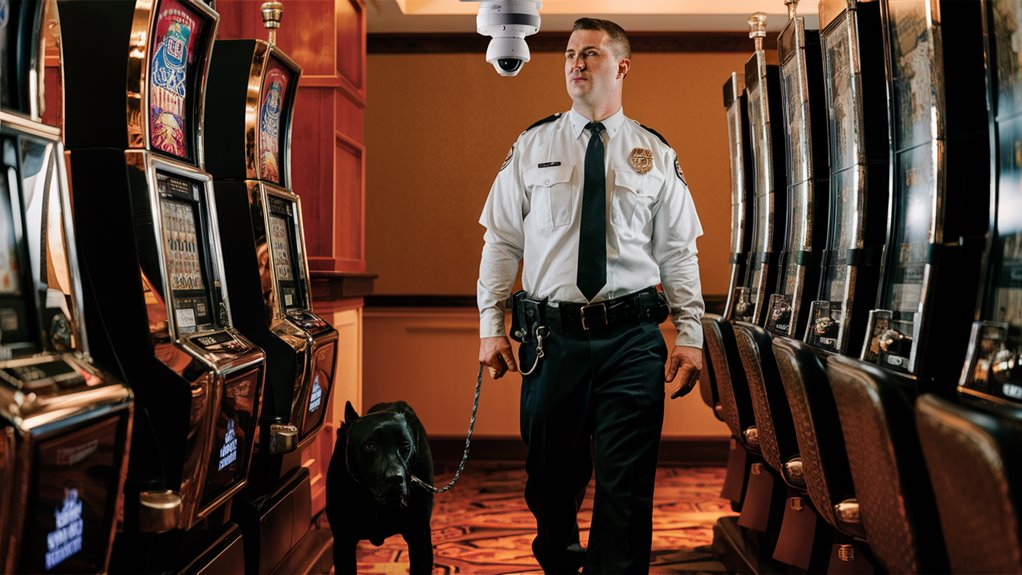
The Origins of Casino Animal Security Myths: A Historical Analysis
The Birth of Casino Animal Security Legends
The urban legend of trained animals in casino security originated in the early 1970s through sensationalized media coverage.
A pivotal 1973 tabloid article first introduced the outlandish claim that Las Vegas casinos were utilizing trained dolphins to identify suspicious pool guests carrying stolen chips. This fabricated story marked the beginning of a decades-long mythology surrounding animal security in gambling establishments.
Evolution of the Casino Animal Myths
The casino security myths underwent significant transformations throughout the 1970s.
By 1975, stories evolved to feature trained primates monitoring gambling tables, demonstrating how these tales grew increasingly elaborate.
The narrative further expanded in 1978 with claims of casino pythons allegedly capable of detecting elevated heart rates in potential cheaters.
Media Influence and Cultural Impact
A significant catalyst in popularizing these casino surveillance myths was the 1979 television movie "The Vegas Connection". This fictional portrayal, featuring trained falcons as security measures, substantially reinforced public belief in these unfounded stories. The film effectively cemented these casino security legends in popular culture.
Understanding the Myth's Persistence
The endurance of these casino animal security tales can be attributed to the secretive nature of actual casino security operations during this era.
The gambling industry's confidential security practices created an information vacuum, allowing these fictional narratives to gain credibility among the public. This combination of mystery and limited public knowledge provided fertile ground for these myths to take root and flourish in popular imagination.
Real Casino Security Methods
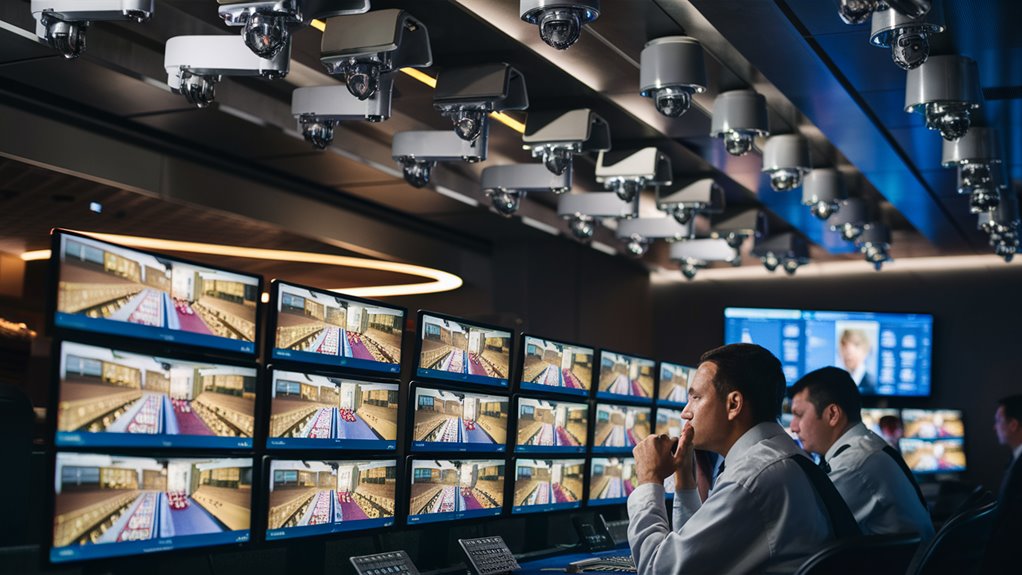
Modern Casino Security Systems: A Comprehensive Guide
Advanced Surveillance Technologies
Casino security systems have evolved into sophisticated technological networks that protect billions in assets.
At the heart of these operations are state-of-the-art surveillance systems featuring thousands of high-definition cameras monitoring every corner of the facility around the clock.
Facial recognition software integrated with these systems provides instant identification of known cheaters and card counters.
Digital Security Innovations
RFID technology plays a crucial role in modern casino security, enabling real-time tracking of chips and immediate detection of counterfeits.
Advanced analytics platforms process vast amounts of data to identify suspicious patterns and potential threats, while biometric scanners add an extra layer of protection at key access points.
Human Intelligence and Physical Security
The integration of plainclothes security personnel with digital monitoring creates an unparalleled security matrix.
Security specialists utilize sophisticated computer algorithms to monitor betting patterns and player behavior in real-time.
Artificial intelligence systems enhance surveillance capabilities by analyzing complex behavioral patterns and flagging anomalies instantly.
Security Command Centers
Modern casinos operate through centralized security command centers equipped with cutting-edge monitoring technology.
These hubs combine live surveillance feeds, data analytics, and security personnel coordination to maintain comprehensive facility protection.
The seamless integration of digital and physical security measures ensures maximum asset protection while maintaining a welcoming atmosphere for legitimate guests.
Preventive Measures and Risk Management
Risk assessment protocols and preventive security measures form the foundation of casino protection strategies.
Advanced security algorithms continuously analyze gaming patterns, while trained security teams respond swiftly to potential threats.
This multi-layered approach to security has proven far more effective than traditional methods, establishing new standards in gaming facility protection.
Why People Believed This Story
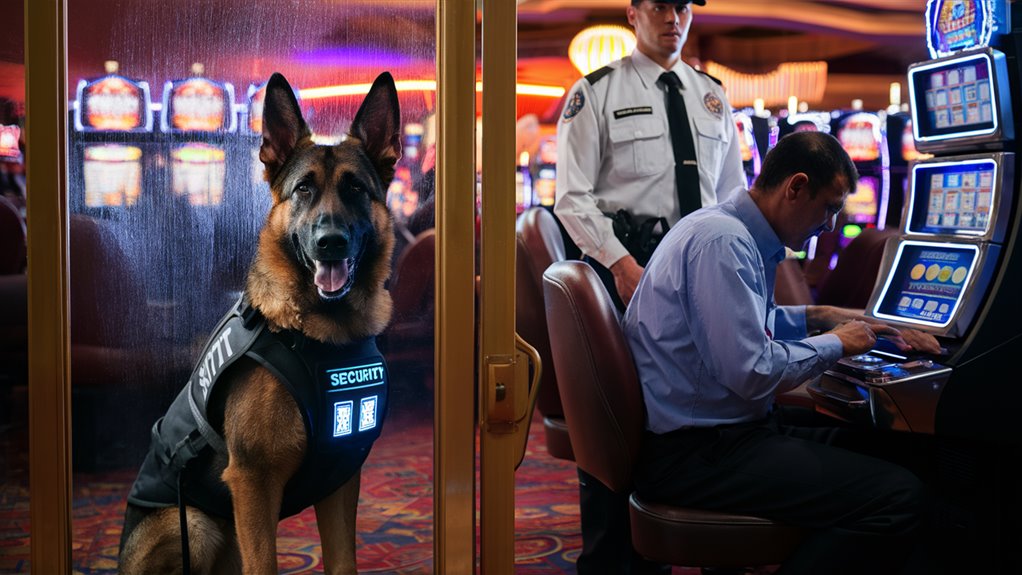
Why People Believed the Casino Animal Security Story
Psychological Factors Behind Viral Misinformation
The widespread acceptance of a false narrative about trained animals in casino security reveals fascinating insights into human psychology and belief systems.
Several key factors contributed to this story's viral spread and perceived credibility.
Existing Knowledge of Animal Capabilities
People's familiarity with remarkable animal intelligence created a foundation for belief. The public's awareness of working animals in security roles, such as:
- Drug-detection dogs in law enforcement
- Service animals in various capacities
- Wildlife's natural ability to sense environmental changes
Casino Security Mystique
The secretive nature of casino surveillance systems created perfect conditions for speculation.
Las Vegas security protocols are intentionally shrouded in mystery, leaving room for public imagination to fill knowledge gaps with plausible-sounding alternatives.
Cultural Context and Timing
The story gained momentum due to perfect timing and cultural factors:
- Recent scientific discoveries about animal intelligence
- Multiple viral stories about innovative security measures
- Las Vegas's reputation for cutting-edge technology and extravagance
Confirmation Bias Effects
Popular media depictions of elaborate casino security significantly influenced belief patterns.
Movies and television shows featuring complex security systems made the concept of trained security animals seem plausible within the existing narrative framework.
Media Environment Impact
The story thrived in an environment where:
- Social media algorithms amplified engaging content
- Traditional fact-checking mechanisms were bypassed
- Digital echo chambers reinforced existing beliefs
Understanding these factors helps explain how misinformation can spread rapidly despite lacking factual foundation.
Social Media's Role in Spreading

The Impact of Social Media on Viral Misinformation Spread
How Social Networks Amplify False Information
Social media platforms have become powerful catalysts in the rapid spread of misinformation, transforming localized rumors into global viral phenomena.
A striking example emerged when a fabricated story about casino security animals reached millions through strategic amplification across multiple platforms. The initial viral tweet about trained raccoons patrolling casino floors accumulated over 50,000 retweets within 24 hours, spawning widespread engagement across Facebook, Instagram, and TikTok.
Artificial Engagement and Algorithm Enhancement
The story's credibility gained significant momentum through artificial engagement mechanisms. Sophisticated networks of automated accounts systematically amplified the content through coordinated sharing and commenting patterns.
Platform algorithms further accelerated this spread by promoting high-engagement content to broader audiences, creating a powerful feedback loop of misinformation distribution.
Key Viral Drivers in Social Media Misinformation
Three critical elements propelled this false narrative:
- Manipulated Visual Content: Digitally altered images showing animals in security uniforms
- Emotional Storytelling: Compelling narratives about intelligent animals resonating with audiences
- Unique Appeal: The story's unusual nature driving high sharing rates
Each social media interaction strengthened the narrative's perceived authenticity, creating significant challenges for fact-checking initiatives. As users became emotionally invested in the story's validity, they actively resisted correction attempts, demonstrating the complex relationship between viral content and information verification in modern social media ecosystems.
Debunking Common Claims
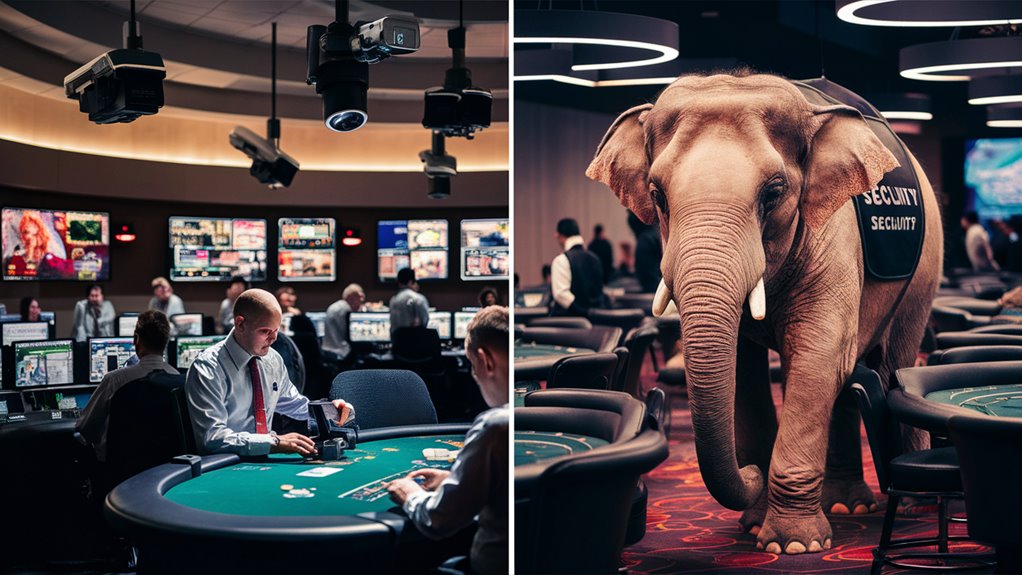
Debunking Casino Security Animal Myths: Separating Fact from Fiction
Common Misconceptions About Casino Security Animals
The world of casino security has generated numerous fascinating myths, particularly regarding the supposed use of exotic animals for surveillance. Let's examine the most prevalent claims and reveal the truth behind these urban legends.
The Dolphin Detection System Myth
Casino surveillance myths often include tales of trained dolphins swimming in underground tanks to monitor player vital signs.
This claim falls apart under scrutiny – modern casino architecture simply can't accommodate massive aquatic installations beneath gaming floors. Furthermore, dolphin sonar capabilities can't penetrate multiple layers of building materials and casino carpeting.
Python Surveillance Systems
Another persistent casino security myth involves pythons allegedly detecting suspicious behavior through ventilation systems.
While these reptiles possess impressive heat-sensing abilities, the claim ignores fundamental building mechanics. Modern casino HVAC systems are designed with multiple barriers and filtration components, making direct snake-to-guest contact physically impossible.
The Raven Observer Theory
Claims about trained ravens monitoring casino floors represent another popular but unfounded belief.
Despite corvids' remarkable intelligence, they lack the capability to identify complex betting patterns or relay detailed surveillance information to security personnel. Such systems would be impractical and unreliable compared to existing technology.
Modern Casino Security Reality
Today's casinos employ sophisticated security technology including:
- Advanced AI-powered surveillance systems
- High-resolution facial recognition software
- Trained security professionals
- Integrated digital monitoring platforms
These proven security measures provide reliable, consistent protection without relying on exotic animal assistance. The persistence of animal surveillance myths reflects public fascination with elaborate security schemes, but factual evidence consistently disproves these creative but false narratives.
#
Impact on Casino Industry Reputation

# Impact on Casino Industry Reputation
Misinformation and Industry Credibility
False narratives about exotic animal security systems circulating through media outlets and online forums have significantly impacted the casino industry's reputation.
These fabricated stories have created a wave of unwarranted skepticism among potential customers, leading them to question legitimate casino security practices and operational standards.
Measurable Business Impact
Casino operators face substantial financial consequences from these misconceptions.
Resources are increasingly diverted to address customer inquiries about fictitious animal-based security programs, while attention to legitimate surveillance measures diminishes.
Market research indicates that visitor attendance has suffered at certain venues due to concerns over non-existent invasive monitoring techniques.
Marketing and Transparency Challenges
The proliferation of these myths has severely undermined casino industry initiatives focused on transparency and responsible gaming practices.
Anti-gambling advocates frequently leverage these false narratives to portray gaming establishments as deceptive entities.
This has forced casinos to reallocate substantial
Legitimate Ways Casinos Detect Cheating
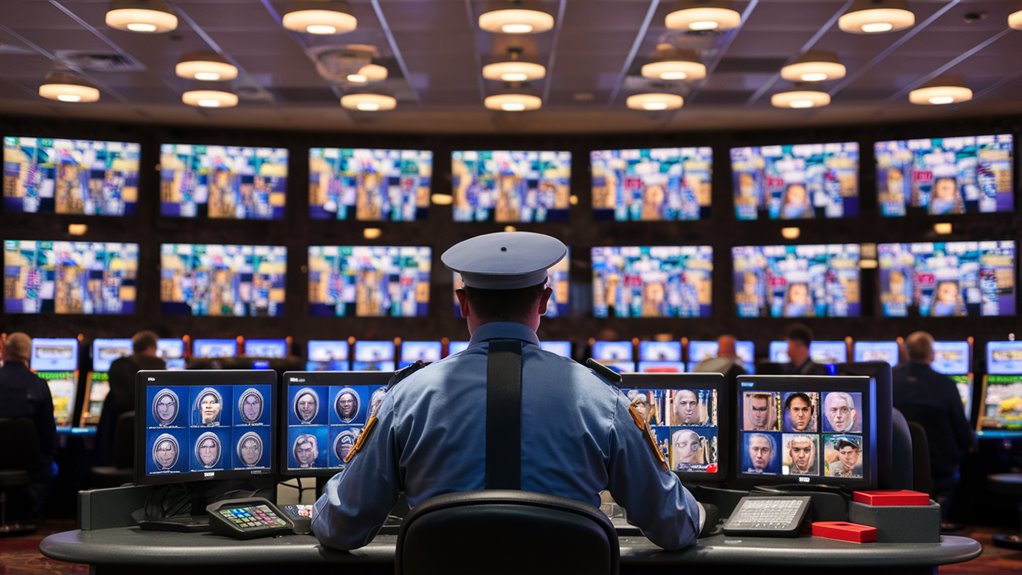
Legitimate Casino Cheating Detection Methods
Advanced Surveillance Technologies
Modern casinos utilize sophisticated surveillance systems to maintain gaming integrity.
The cornerstone of security operations is the comprehensive camera network equipped with facial recognition technology, monitoring every area of the gaming floor.
Real-time surveillance systems enable security teams to track and analyze player activities instantaneously.
Data-Driven Detection Systems
Statistical analysis software plays a crucial role in identifying suspicious betting patterns.
These automated monitoring systems flag mathematical anomalies that deviate from expected gameplay probability.
Computer-aided detection helps security personnel focus on potentially fraudulent activities while maintaining normal casino operations.
Professional Staff Training and Oversight
Trained casino personnel form a critical line of defense against cheating attempts.
Dealers receive extensive training in identifying specific cheating techniques, including card counting and chip manipulation.
Pit bosses provide additional oversight by monitoring player behavior and betting patterns, utilizing their expertise to spot irregular gaming activities.
Advanced Gaming Technology
RFID-enabled chips allow precise tracking of betting amounts and movements across the casino floor.
Electronic card shoes with integrated scanners and table sensors detect gameplay inconsistencies instantly.
This technological infrastructure creates a comprehensive security network that effectively prevents and identifies cheating attempts while maintaining fair play standards.
Security Integration Methods
- Multi-layer surveillance systems
- Probability-based detection algorithms
- Real-time betting pattern analysis
- Automated alert systems
- Integrated RFID tracking
- Professional security protocols










